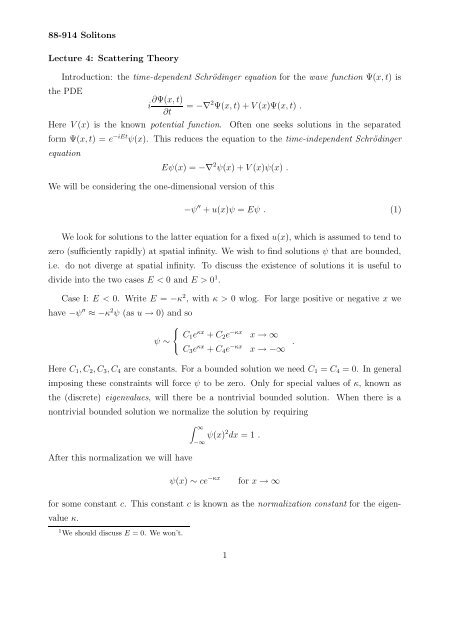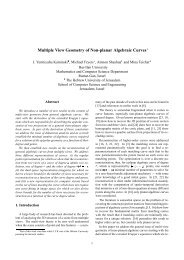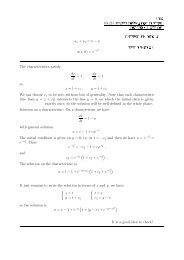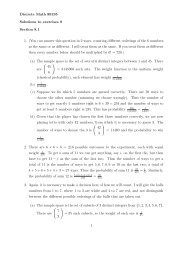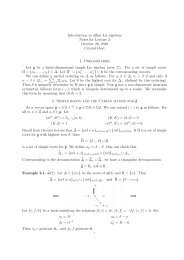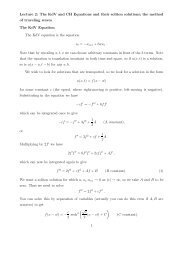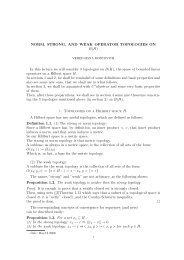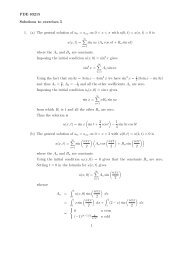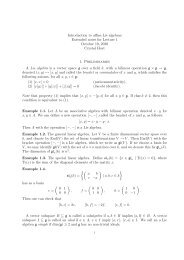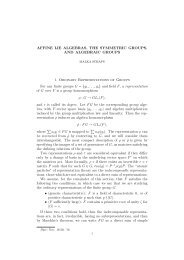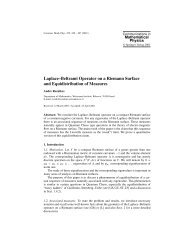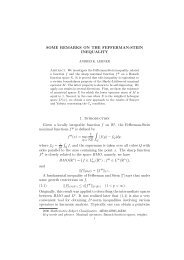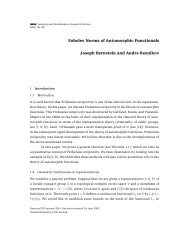the time-dependent Schrödinger equation for the wave function Ψ(x
the time-dependent Schrödinger equation for the wave function Ψ(x
the time-dependent Schrödinger equation for the wave function Ψ(x
Create successful ePaper yourself
Turn your PDF publications into a flip-book with our unique Google optimized e-Paper software.
88-914 SolitonsLecture 4: Scattering TheoryIntroduction: <strong>the</strong> <strong>time</strong>-<strong>dependent</strong> <strong>Schrödinger</strong> <strong>equation</strong> <strong>for</strong> <strong>the</strong> <strong>wave</strong> <strong>function</strong> <strong>Ψ</strong>(x, t) is<strong>the</strong> PDE∂<strong>Ψ</strong>(x, t)i = −∇ 2 <strong>Ψ</strong>(x, t) + V (x)<strong>Ψ</strong>(x, t) .∂tHere V (x) is <strong>the</strong> known potential <strong>function</strong>. Often one seeks solutions in <strong>the</strong> separated<strong>for</strong>m <strong>Ψ</strong>(x, t) = e −iEt ψ(x). This reduces <strong>the</strong> <strong>equation</strong> to <strong>the</strong> <strong>time</strong>-in<strong>dependent</strong> <strong>Schrödinger</strong><strong>equation</strong>Eψ(x) = −∇ 2 ψ(x) + V (x)ψ(x) .We will be considering <strong>the</strong> one-dimensional version of this−ψ ′′ + u(x)ψ = Eψ . (1)We look <strong>for</strong> solutions to <strong>the</strong> latter <strong>equation</strong> <strong>for</strong> a fixed u(x), which is assumed to tend tozero (sufficiently rapidly) at spatial infinity. We wish to find solutions ψ that are bounded,i.e. do not diverge at spatial infinity. To discuss <strong>the</strong> existence of solutions it is useful todivide into <strong>the</strong> two cases E < 0 and E > 0 1 .Case I: E < 0. Write E = −κ 2 , with κ > 0 wlog. For large positive or negative x wehave −ψ ′′ ≈ −κ 2 ψ (as u → 0) and so⎧⎨ C 1 e κx + C 2 e −κx x → ∞ψ ∼⎩ C 3 e κx + C 4 e −κx x → −∞ .Here C 1 , C 2 , C 3 , C 4 are constants. For a bounded solution we need C 1 = C 4 = 0. In generalimposing <strong>the</strong>se constraints will <strong>for</strong>ce ψ to be zero. Only <strong>for</strong> special values of κ, known as<strong>the</strong> (discrete) eigenvalues, will <strong>the</strong>re be a nontrivial bounded solution.nontrivial bounded solution we normalize <strong>the</strong> solution by requiringAfter this normalization we will have∫ ∞−∞ψ(x) 2 dx = 1 .When <strong>the</strong>re is aψ(x) ∼ ce −κx<strong>for</strong> x → ∞<strong>for</strong> some constant c. This constant c is known as <strong>the</strong> normalization constant <strong>for</strong> <strong>the</strong> eigenvalueκ.1 We should discuss E = 0. We won’t.1
Case 2: E > 0. Write E = k 2 . For large positive or negative x we have −ψ ′′ ≈ k 2 ψ (asu → 0) and so⎧⎨ C 1 e ikx + C 2 e −ikx x → ∞ψ ∼⎩ C 3 e ikx + C 4 e −ikx x → −∞ .Here C 1 , C 2 , C 3 , C 4 are constants. We see that in <strong>the</strong> case E ≥ 0 <strong>the</strong> general solution isbounded. Typically we will work with certain special solutions of <strong>the</strong> <strong>equation</strong>. The firstspecial solutions we will consider are <strong>the</strong> Jost solutions ψ + , ψ − defined (respectively) by <strong>the</strong>conditionsψ + (x, k) ∼ e ikx , x → ∞ ,ψ − (x, k) ∼ e −ikx , x → −∞ .Existence of <strong>the</strong>se solutions is guaranteed <strong>for</strong> all k, as <strong>the</strong>y are each specified only by “initial”conditions at ±∞. Since <strong>the</strong> <strong>Schrödinger</strong> <strong>equation</strong> only depends on k 2 , note that ψ + (x, −k)and ψ − (x, −k) are also solutions, satisfying boundary conditionsψ + (x, −k) ∼ e −ikx , x → ∞ ,ψ − (x, −k) ∼ e +ikx , x → −∞ .The general solution can be expressed ei<strong>the</strong>r as a linear combination of ψ + (x, k) andψ + (x, −k), or as a linear combination of ψ − (x, k) and ψ − (x, k).Physicists more commonly work with a different special solution of <strong>the</strong> Scrödinger <strong>equation</strong>known as <strong>the</strong> scattering solution, ˆψ(x, k), determined by boundary conditions⎧⎨ eˆψ(x, −ikx + r(k)e ikx x → ∞k) ∼⎩ t(k)e −ikx x → −∞ .r(k) and t(k) are known as <strong>the</strong> reflection and transmission coefficients respectively. (For <strong>the</strong>purpose of understanding <strong>the</strong> terminology, note that <strong>for</strong> k > 0 and E > 0 <strong>the</strong> <strong>wave</strong> <strong>function</strong>ψ(x) = e ikx of <strong>the</strong> <strong>time</strong>-in<strong>dependent</strong> <strong>Schrödinger</strong> <strong>equation</strong> corresponds to a <strong>wave</strong> <strong>function</strong><strong>Ψ</strong>(x, t) = e i(kx−Et) of <strong>the</strong> <strong>time</strong>-<strong>dependent</strong> <strong>Schrödinger</strong> <strong>equation</strong>, which is a right-moving<strong>wave</strong>, while <strong>the</strong> <strong>wave</strong> <strong>function</strong> ψ(x) = e −ikx corresponds to a left-moving <strong>wave</strong>.)The existence of <strong>the</strong> scattering solution is not guaranteed, as it is specified by boundaryconditions.We now prove <strong>the</strong> following: <strong>for</strong> each real k <strong>the</strong>re exists a uniquescattering solution with |r(k)| 2 + |t(k)| 2 = 1.Proof:As already mentioned, we can write <strong>the</strong> general solution of <strong>the</strong> <strong>Schrödinger</strong><strong>equation</strong> as a linear combination of ψ − (x, k) and ψ − (x, −k). In particular, <strong>for</strong> some a(k)2
and b(k) we can always writeψ + (x, k) = a(k)ψ − (x, k) + b(k)ψ − (x, −k)ψ + (x, −k) = a(−k)ψ − (x, −k) + b(−k)ψ − (x, k)Note that if ψ 1 , ψ 2 are any two solutions of <strong>the</strong> <strong>Schrödinger</strong> <strong>equation</strong> <strong>for</strong> <strong>the</strong> same value ofk, <strong>the</strong>nψ 1 (−ψ ′′2 + u(x)ψ 2 − k 2 ψ 2 ) − ψ 2 (−ψ ′′1 + u(x)ψ 1 − k 2 ψ 1 ) = 0⇒ ψ 1 ψ ′′2 − ψ 2ψ ′′1 = 0⇒ ψ 1 ψ ′ 2 − ψ 2ψ ′ 1 = constant .(The quantity on <strong>the</strong> LHS of <strong>the</strong> last <strong>equation</strong>s is known as <strong>the</strong> Wronskian of ψ 1 , ψ 2 .) Using<strong>the</strong> asymptotics at x = +∞ we haveψ + (x, k)ψ ′ + (x, −k)) − ψ +(x, −k)ψ ′ + (x, k) = eikx (−ike −ikx ) − e −ikx (ike ikx ) = −2ik .Using <strong>the</strong> asymptotics at x = −∞ we haveψ + (x, k)ψ ′ +(x, −k)) − ψ + (x, −k)ψ ′ +(x, k)= (a(k)e −ikx + b(k)e ikx )(ika(−k)e ikx − ikb(−k)e −ikx )(a(−k)e ikx + b(−k)e −ikx )(−ika(k)e −ikx + ikb(k)e ikx )= 2ik(a(k)a(−k) − b(k)b(−k))and thus b(k)b(−k) − a(k)a(−k) = 1.So far we have not used <strong>the</strong> assumption that k is real (as we will need to do all this<strong>the</strong>ory again later <strong>for</strong> complex k), but <strong>for</strong> real k it is quite clear that ψ + (a, −k) = ψ + (x, k) ∗ ,ψ − (a, −k) = ψ − (x, k) ∗ , a(−k) = a(k) ∗ and b(−k) = b(k) ∗ . Thus we have |b(k)| 2 − |a(k)| 2 =1, and in particular b(k) ≠ 0.Now <strong>the</strong> problem with <strong>the</strong> existence of <strong>the</strong> scattering solution is that it is specified usingboundary conditions. For any <strong>function</strong> r(k) we can uniquely specify a solution by requiringonly <strong>the</strong> condition at x = +∞. The question is can we chose an appropriate r(k) such that<strong>the</strong> condition at x = −∞ is also satisfied. Note <strong>the</strong> condition at +∞ impliesand henceˆψ(x, k) = ψ + (x, −k) + r(k)ψ + (x, k) ,ˆψ(x, k) = (a(−k)ψ − (x, −k) + b(−k)ψ − (x, k)) + r(k)(a(k)ψ − (x, k) + b(k)ψ − (x, −k))= (a(−k) + b(k)r(k))ψ − (x, −k) + (b(−k) + a(k)r(k))ψ − (x, k) .3
To satisfy <strong>the</strong> boundary condition at −∞ requires that r(k) = −a(−k)/b(k) and t(k) =b(−k)+a(k)r(k). Since we know that <strong>for</strong> real k, b(k) ≠ 0, we can always find an appropriater(k). For complex k we will see <strong>the</strong>re is a possibility that b(k) = 0. Provided r(k) and t(k)can be defined we havesot(k) = b(−k) − a(k)a(−k)b(k)t(k)t(−k) + r(k)r(−k) =In particular <strong>for</strong> k real, |r(k)| 2 + |t(k)| 2 = 1. QED.= 1b(k) ,1b(k)b(−k) + a(−k)a(k)b(k)b(−k) = 1It is useful at this stage to work through an example. We consider <strong>the</strong> simple potential<strong>function</strong>u(x) = U 0 δ(x) .A series of straight<strong>for</strong>ward calculations establishes <strong>the</strong> following: if U 0 ≥ 0 <strong>the</strong>re are noeigenvalues, and if U 0 < 0 <strong>the</strong>re is a single eigenvaluewith normalization constant c = √ κ.respectively,t(k) =kk + iU 0 /2κ = − U 02which clearly satisfy |r(k)| 2 + |t(k)| 2 = 1 <strong>for</strong> real k.The transmission and reflection coefficients are,r(k) = −iU 0/2k + iU 0 /2The process of taking a potential u(x) and calculating <strong>the</strong> scattering data, i.e. <strong>the</strong> eigenvaluesκ, <strong>the</strong> corresponding normalization constants c, and <strong>the</strong> transmission and reflectioncoefficients t(k) and r(k) <strong>for</strong> real k (<strong>the</strong>se satisfy |r(k)| 2 + |t(k)| 2 = 1) is known as <strong>the</strong> scatteringtrans<strong>for</strong>m. In <strong>the</strong> next few lectures we will establish <strong>the</strong> remarkable fact that given<strong>the</strong> scattering data it is possible to reconstruct <strong>the</strong> potential, using what is known as <strong>the</strong>inverse scattering trans<strong>for</strong>m.At this stage it is worthwhile to solve <strong>the</strong> scattering problem <strong>for</strong> <strong>the</strong> following potentials:1.⎧⎨ U 0 |x| < au(x) =⎩ 0 |x| > aFor this potential you will benefit by using Maple.2. u(x) = U 0 sech 2 x. For this potential solving <strong>the</strong> <strong>Schrödinger</strong> involves associated Legendre<strong>function</strong>s, see (if necessary) <strong>the</strong> book of Drazin and Johnson.4
Lecture 5: The Kernel of <strong>the</strong> Jost FunctionThe inverse scattering trans<strong>for</strong>m proceeds through an intermediate object, known as <strong>the</strong>kernel of <strong>the</strong> Jost <strong>function</strong> (by “intermediate” I mean that we use <strong>the</strong> scattering data toconstruct <strong>the</strong> kernel of <strong>the</strong> Jost <strong>function</strong>, and <strong>the</strong>n <strong>the</strong> latter to construct u(x)). This lectureis devoted to this remarkable <strong>function</strong>.Recall: <strong>the</strong> Jost solution is <strong>the</strong> solution ψ + (x, k) of −ψ ′′ + u(x)ψ = k 2 ψ satisfying <strong>the</strong>condition ψ + (x, k) ∼ e ikx as x → ∞. Let us write ψ + (x, k) = e ikx φ(x, k). Then φ satisfies<strong>the</strong> differential <strong>equation</strong>φ ′′ + 2ikφ ′ − u(x)φ = 0 , φ ∼ 1 x → ∞ .It is possible to write a <strong>for</strong>mal series solution <strong>for</strong> this <strong>equation</strong> in <strong>the</strong> <strong>for</strong>mφ =∞∑i=0φ i (x)k i , φ 0 (x) = 1 .To verify this, just substitute <strong>the</strong> series into <strong>the</strong> <strong>equation</strong>; <strong>the</strong> coefficients φ i (x) should bedetermined by <strong>the</strong> recursionφ i+1 = i 2 (φ′′ i − u(x)φ i ) , i = 0, 1, 2, . . .and if φ 0 (x) = 1 <strong>the</strong>n we will clearly have lim x→∞ φ i (x) = 0 <strong>for</strong> all i > 0, so all necessaryconditions are satisifed. A consequence of this is that <strong>for</strong> large |k| <strong>the</strong> <strong>function</strong> ψ + (x, k)−e ikxbehaves as 1 , and we can thus consider its inverse Fourier trans<strong>for</strong>m. That is, we can write|k|ψ + (x, k) = e ikx +∫ ∞−∞K(x, y)e iky dy (2)<strong>for</strong> some <strong>function</strong> K(x, y), known as <strong>the</strong> kernel of <strong>the</strong> Jost <strong>function</strong>. This <strong>function</strong> K(x, y)will play a central role in what follows and we will now develop its properties.Note that since ψ + (x, k) ∼ e ikx as x → ∞ we must have lim x→∞ K(x, y) = 0 (<strong>for</strong> everyy). Assuming u(x) tends to zero sufficiently fast we will even have lim x→∞ K x (x, y) = 0. Itis also <strong>the</strong> case that as a <strong>function</strong> of y K tends to zero as y → ∞, this is a consequence of <strong>the</strong>smooth dependence of ψ + on k. Be warned, though, that while K behaves nicely at infinity,it need not even be continuous (in fact, since we have seen that its Fourier trans<strong>for</strong>m onlydrops off as 1/|k| <strong>for</strong> large k, we should expect discontinuities). We are going to convenientlyignore this and do things like differentiate K. Once we have <strong>the</strong> results we need we shouldgo back and do some a posteriori justification, but we will be a bit lazy about this.Substituting (2) into <strong>the</strong> <strong>Schrödinger</strong> <strong>equation</strong> and simplifying we find∫ ∞( ∫ ∞) ∫ ∞− K xx (x, y)e iky dy + u(x) e ikx + K(x, y)e iky dy = k 2 K(x, y)e iky dy .−∞−∞5−∞
Taking <strong>the</strong> Fourier inverse trans<strong>for</strong>m we find that K obeys <strong>the</strong> inhomogeneous <strong>wave</strong> <strong>equation</strong>K xx (x, y) − K yy (x, y) − u(x)K(x, y) = u(x)δ(x − y) .Suppose that instead of <strong>the</strong> conditions K, K x → 0 as x → ∞ we knew that K = K x = 0on <strong>the</strong> line x = M (M large). Then what we would have here is an inhomogeneous <strong>wave</strong><strong>equation</strong>, with characteristics parallel to x = ±y, initial data on x = M and a nontrivialsource term on <strong>the</strong> line x = y. See <strong>the</strong> diagram.We deduce <strong>the</strong> following results:1. K(x, y) = 0 <strong>for</strong> x > y. (Needs verbal explanation.)2. K xx (x, y) − K yy (x, y) − u(x)K(x, y) = 0 <strong>for</strong> x < y.3. u(x) = −2(K x (x, x) + K y (x, x)) = −2 d K(x, x). (From <strong>the</strong> first result we can writedxK(x, y) = Q(x, y)H(y − x). We <strong>the</strong>n haveK xx − K yy − uK = (Q xx − Q yy − uQ)H(y − x) − 2(Q x + Q y )δ(y − x)and <strong>the</strong> coefficients of δ(y − x) need to match.)Note that K is real!Note that in light of <strong>the</strong> first result we can write <strong>the</strong> relation between ψ + and K asψ + (x, k) = e ikx +∫ ∞xK(x, y)e iky dy . (3)6
Example: u(x) = U 0 δ(x). Compute <strong>the</strong> Jost solution. Findψ + (x, k) = e ikx + U 0 sin kxH(−x) .kCan find <strong>the</strong> kernel of <strong>the</strong> Jost <strong>function</strong> by Fourier trans<strong>for</strong>m. GetK(x, y) = U 0H(−x)2π∫ ∞−∞−iky sin kxe dk .kTo compute this integral: best to teach a “trick” way usingGet∫1 ∞e −ikq dk = δ(q) .2π −∞K(x, y) = U 0H(−x)(H(y + x) − H(y − x)) =2⎧⎨⎩U 02x < y < −x0 o<strong>the</strong>rwise(Note x < y < −x implies x < 0!) You can compute u(x) from this using u(x) =−2 ddx K(x, x) and K(x, x) = − U 02H(−x). To get <strong>the</strong> latter, note that by K(x, x) we actuallymean lim y↓x K(x, y). Also remember that H(2x)H(−x) = 0.You might want to try to work out <strong>the</strong> kernel of <strong>the</strong> Jost <strong>function</strong> <strong>for</strong> <strong>the</strong> two examplesgiven as exercises in <strong>the</strong> last lecture. Be warned that in <strong>the</strong> first case <strong>the</strong>re is no explicit<strong>for</strong>mula <strong>for</strong> <strong>the</strong> answer, but much in<strong>for</strong>mation can be gained by asymptotic methods.7
Lecture 6: The Inverse Scattering Trans<strong>for</strong>mWe start with a summary of <strong>the</strong> last two lectures: we looked at <strong>the</strong> solution of <strong>the</strong><strong>Schrödinger</strong> <strong>equation</strong> −ψ ′′ + u(x)ψ = Eψ. For E < 0 we write E = −κ 2 . There are onlybounded solutions <strong>for</strong> certain values of κ, known as <strong>the</strong> eigenvalues.solutions by requiringWe <strong>the</strong>n have∫ ∞−∞ψ 2 dx = 1 .⎧⎨ ce −κx x → ∞ψ ∼⎩ de κx x → −∞ ,We normalize <strong>the</strong>where <strong>the</strong> normalization constants c, d depend on κ. For E > 0 we write E = k 2 . For everyk <strong>the</strong>re are bounded solutions. We can consider <strong>the</strong> Jost solutions, defined byψ ± (x, k) → e ±ikx , x → ±∞ .Ei<strong>the</strong>r <strong>the</strong> pair ψ + (x, k), ψ + (x, −k) or <strong>the</strong> pair ψ − (x, k), ψ − (x, −k) <strong>for</strong>m a basis of <strong>the</strong> spaceof solutions. We can thus write<strong>for</strong> some <strong>function</strong>s a(k), b(k) which satisfyψ + (x, k) = a(k)ψ − (x, k) + b(k)ψ − (x, −k) (4)|b(k)| 2 − |a(k)| 2 = 1We can also consider <strong>the</strong> scattering solutions ˆψ that satisfies <strong>the</strong> boundary conditions⎧⎨ eˆψ(x, −ikx + r(k)e ikx x → ∞k) ∼⎩ t(k)e −ikx x → −∞ .We showed that this solution always exists, thatr(k) = − a(−k)b(k)and t(k) = 1b(k) ,and also that|r(k)| 2 + |t(k)| 2 = 1 .This was <strong>the</strong> content of <strong>the</strong> first lecture. In <strong>the</strong> second lecture we showed <strong>the</strong> existenceof a kernel K(x, y) such thatand with <strong>the</strong> propertiesψ + = e ikx +∫ ∞−∞K(x, y)e iky dy8
1. K(x, y) = 0 <strong>for</strong> x > y.2. K xx (x, y) − K yy (x, y) − u(x)K(x, y) = 0 <strong>for</strong> x < y.3. u(x) = −2 d K(x, x) (where K(x, x) is <strong>the</strong> limit of K(x, y) as y tends to x from above.)dxThe essence of inverse scattering is as follows: we will show how to use <strong>the</strong> scatteringdata (<strong>the</strong> κ’s, <strong>the</strong> c’s and r(k)) to find K(x, y), and from this u can be found. The finalresult can be written very simply: if we defineF (x) =∑all eigenvaluesc 2 e −κx + 1 ∫ ∞r(k)e ikx dk (5)2π −∞<strong>the</strong>n K(x, y) can be determined from <strong>the</strong> Gelfand Levitan Marchenko (GLM) <strong>equation</strong>so0 = K(x, z) + F (x + z) +∫ ∞−∞F (y + z)K(x, y)dy , z > x . (6)We mention one o<strong>the</strong>r fact that we have already seen: <strong>for</strong> large |k|ψ + (x) = e ikx + O( ) 1|k|andψ − (x) = e −ikx + O( )( )11b(k) = 1 + O , a(k) = O ,|k||k|( )( )11t(k) = 1 + O , r(k) = O .|k||k|( ) 1|k|In particular <strong>the</strong> integral in <strong>the</strong> definition of F is well-defined. We also mention one o<strong>the</strong>rfact that we have not yet seen: by computing Wronskians <strong>the</strong> coefficients a(k), b(k) can beseen to satsifya(k) = W (ψ +(x, k), ψ − (x, −k))W (ψ − (x, k), ψ − (x, −k)) = W (ψ +(x, k), ψ − (x, −k))2ik,b(k) =W (ψ +(x, k), ψ − (x, k))W (ψ − (x, −k), ψ − (x, k)) = W (ψ +(x, k), ψ − (x, k))−2ik(Reminder: W (f, g) = fg ′ − f ′ g.) Here we assume k ≠ 0.(7)The first step of proving GLM is as follows: We can represent ˆψ using <strong>the</strong> kernel of <strong>the</strong>Jost <strong>function</strong> asˆψ(x, k) = ψ + (x, −k) + r(k)ψ + (x, k)= e −ikx +∫ ∞−∞e −iky K(x, y)dy + r(k)9( ∫ ∞)e ikx + e iky K(x, y)dy−∞.
Multiplying by e ikz , dividing by 2π and integrating over k gives∫1 ∞2π −∞( ˆψ(x, k) − e −ikx )e ikz dk = K(x, z) + 12π+ 1 ∫ ∞r(k)2π −∞∫ ∞−∞(∫ ∞r(k)e ik(x+z) dk−∞)e iky K(x, y)dy e ikz dk .Assuming that we can change <strong>the</strong> order in <strong>the</strong> double integral, this becomes∫1 ∞(2πˆψ(x,∫ ∞k)e ikx − 1)e ik(z−x) dk = K(x, z) + F 0 (x + z) + F 0 (y + z)K(x, y) dy , (8)−∞−∞whereF 0 (x) = 1 ∫ ∞r(k)e ikx dk .2π −∞Note <strong>the</strong> left hand side can be writtenThe logic now proceeds as follows:∫1 ∞ (ψ− (x, k)e ikx t(k) − 1 ) e ik(z−x) dk . (9)2π −∞1. We show that <strong>the</strong> Jost solutions ψ ± (x, k) can be extended to <strong>the</strong> upper half k-plane,and are analytic <strong>the</strong>re (except possibly at k = 0; we omit all discussion of k = 0,which leng<strong>the</strong>ns things significantly, but is merely a technical issue). It follows thatb(k) can be analytically extended to <strong>the</strong> upper half k-plane (except possible at k = 0)using <strong>the</strong> <strong>for</strong>mula (7).2. We show that <strong>for</strong> large |k| (in <strong>the</strong> upper half k-plane) both ψ − (x, k)e ikx and b(k) are1 + O(1/|k|). We show that <strong>the</strong> only zeros of b(k) in <strong>the</strong> upper half k-plane are simplezeros at k = iκ, where κ are <strong>the</strong> eigenvalues of <strong>the</strong> <strong>Schrödinger</strong> <strong>equation</strong>.3. Thus <strong>for</strong> z > x <strong>the</strong> integral (9) can be computed as a sum of residues and this givesus <strong>the</strong> final <strong>for</strong>m of <strong>the</strong> GLM <strong>equation</strong>.Here are <strong>the</strong> full details:1. Proof of existence and analyticity of ψ + <strong>for</strong> k in <strong>the</strong> upper half plane (ψ − is similar).Writeψ + = e ikx φ .Then φ must satisfyφ ′′ + 2ikφ ′ − uφ = 0 , φ → 1 as x → ∞ .10
By <strong>the</strong> method of “variation of constants” it can be shown that <strong>the</strong> solution ofsatisfying φ → 1 as x → ∞ isφ(x) = 1 +φ ′′ + 2ikφ ′ = f∫ ∞Thus we seek a solution φ of <strong>the</strong> integral <strong>equation</strong>φ(x) = 1 +∫ ∞xxf(y) e2ik(y−x) − 1dy .2iku(y)φ(y) e2ik(y−x) − 1dy .2ikTo construct <strong>the</strong> solution we use a standard recursive procedure (<strong>the</strong> “method ofsuccessive approximations”): let φ 0 (x) = 0 and defined a sequence φ 1 , φ 2 , . . . byφ n+1 (x) = 1 +∫ ∞xu(y)φ n (y) e2ik(y−x) − 1dy , n = 0, 1, 2, . . .2ikIf this sequence converges, its limit is <strong>the</strong> solution we seek. But does <strong>the</strong> sequenceconverge? Note that <strong>for</strong> n > 0 we haveφ n+1 (x) − φ n (x) =∫ ∞xu(y)(φ n (y) − φ n−1 (y)) e2ik(y−x) − 1dy .2ikIf k = η + iκ with κ ≥ 0 (i.e. <strong>for</strong> k in <strong>the</strong> upper half plane including <strong>the</strong> real axis),<strong>the</strong>n e 2ik(y−x) is of absolute value less than 1, soClaim:|φ n+1 (x) − φ n (x)| ≤ 1|k|∫ ∞|φ n+1 (x) − φ n (x)| ≤ 1 n!x|u(y)||φ n (y) − φ n−1 (y)|dy .( ∫ 1 ∞n|u(y)|dy).|k| xFor n = 0 this is trivial as φ 1 (x) = 1, <strong>for</strong> n > 0 it is straight<strong>for</strong>ward to prove byinduction. It follows that <strong>the</strong> sum∞∑n=0(φ n+1 (x) − φ n (x))converges absolutely as it is majorized by <strong>the</strong> Taylor series of( ∫ )1 ∞exp |u(y)|dy .|k| xNote all this assumes k ≠ 0. For k = 0 we have to look at <strong>the</strong> solution of <strong>the</strong> integral<strong>equation</strong>φ(x) = 1 +∫ ∞xu(y)φ(y)(y − x)dy ,which we will not do here. Analyticity of φ(x, k) follows from <strong>the</strong> standard result that<strong>the</strong> limit of a uni<strong>for</strong>mly convergent sequence of analytic <strong>function</strong>s is itself analytic(each of <strong>the</strong> <strong>function</strong> φ n (x, k) are analytic in k).11
2. The behaviors <strong>for</strong> large |k| are obtained in <strong>the</strong> same way as in <strong>the</strong> case of real k. Asregards <strong>the</strong> location of zeros of b(k): we need to prove that all <strong>the</strong> zeros of b(k) in <strong>the</strong>upper half plane lie on <strong>the</strong> imaginary axis. and have <strong>the</strong> <strong>for</strong>m k = iκ where κ is aneigenvalue of <strong>the</strong> <strong>Schrödinger</strong> <strong>equation</strong>.Suppose b(k) = 0 <strong>for</strong> k = η + iκ. We already know b(k) does not vanish on <strong>the</strong> realaxis, so we can assume κ > 0. From (7), if b(k) = 0 <strong>the</strong>re must exist some constanta(k) such thatψ + (x, k) = a(k)ψ − (x, k) .[There is danger of some confusion here: <strong>for</strong> all real k <strong>the</strong> relation (4) holds. For k in<strong>the</strong> upper half plane ψ ± (x, k) are both defined, and so is b(k), using (7), but ψ − (x, −k)need not be defined. So <strong>the</strong> relation (4) makes no sense <strong>for</strong> general k in <strong>the</strong> upper halfplane. But <strong>for</strong> those k <strong>for</strong> which b(k) = 0, we see <strong>the</strong>re is such a relationship.] Now weknow that ψ + (x, k) ∼ e ikx as x → ∞ and ψ − (x, k) ∼ e −ikx as x → −∞. Since κ > 0this implies that ψ + (x, k) → 0 exponentially as x → ±∞. Consider now <strong>the</strong> complexconjugate ψ+ ∗ of ψ + . This satisfies−(ψ ∗ +) ′′ + u(x)ψ ∗ + = (k ∗ ) 2 ψ ∗ +as ψ + satisfies−ψ ′′ + + u(x)ψ + = k 2 ψ + .Multiply <strong>the</strong> first of <strong>the</strong>se <strong>equation</strong> by ψ + , <strong>the</strong> second by ψ ∗ +and subtract. We obtain(ψ ∗ + ψ′ + − ψ +(ψ ∗ + )′ ) ′ == ((k ∗ ) 2 − k 2 )ψ + ψ ∗ + .Integrating, and using <strong>the</strong> fact that ψ + tends to zero at both ±∞, we deduce∫ ∞((k ∗ ) 2 − k 2 ) ψ + ψ+ ∗ dx = 0 .−∞The integral cannot vanish, so we must have k = ±k ∗ , i.e. k is ei<strong>the</strong>r real or pureimaginary. The latter is not allowed, thus k must be pure imaginary.When b(k) = 0 with k = iκ we have⎧⎨ e −κx x → ∞ψ + →⎩ a(iκ)e κx x → −∞ .Thus at once <strong>the</strong> roots in <strong>the</strong> upper half plane of b(k) are precisely of <strong>the</strong> <strong>for</strong>m iκ,where κ is an eigenvalue of <strong>the</strong> <strong>Schrödinger</strong> <strong>equation</strong>. QED.12
3. Since we now know where <strong>the</strong> poles of <strong>the</strong> integrand in (9) are, and we know that <strong>the</strong>expression multiplying e ik(x−x) is of order 1/|k| <strong>for</strong> large k, we can now evaluate (9)using <strong>the</strong> residue <strong>the</strong>orem. We get∫ (1 ∞ ψ− (x, k)e ikx )− 1 e ik(z−x) dk = ∑ 2π −∞ b(k)κiψ − (x, iκ)e −κz res( )∣1∣∣∣∣k=iκ.b(k)Since κ is an eigenvalue we have cψ + (x, iκ) = dψ − (x, iκ) so we can write <strong>the</strong> integral∑κicrd ψ +(x, iκ)e −κz ,where r denotes res ( )∣1 ∣∣k=iκ. In terms of <strong>the</strong> Kernel of <strong>the</strong> Jost <strong>function</strong> this isb(k)∑Inserting in (8) we have∑κoricrd0 = K(x, z)+κicrd(∫ ∞)e −κ(x+z) + K(x, y)e −κ(y+z) dy−∞(∫ ∞)∫ ∞e −κ(x+z) + K(x, y)e −κ(y+z) dy = K(x, z)+F 0 (x+z)+ F 0 (y+z)K(x, y) dy ,−∞−∞(F 0 (x + z) − ∑ κThus we reach <strong>the</strong> GLM <strong>equation</strong> (6) provided) ∫ (icr∞d e−κ(x+z) + F 0 (y + z) − ∑−∞κ.icrd e−κ(y+z) )K(x, y) dy .F (x) = F 0 (x) − ∑ κicrd e−κx .From here on not done in classTo reach <strong>the</strong> final <strong>for</strong>m of F (5) we need to compute <strong>the</strong> residue r. We haver = res( )∣1∣∣∣∣k=iκ= 1dbb(k)(iκ) ,dkon <strong>the</strong> assumption that <strong>the</strong> zero of b(k) at iκ is simple, which we are about to justify.Using (7) we havedbdk = W (ψ +k, ψ − ) + W (ψ + , ψ −k )+ W (ψ +, ψ − ).−2ik2ik 2When k = iκ <strong>the</strong> last term is zero, and also dψ − = cψ + . Socdbdk (iκ) = W (ψ d +k, ψ + ) + dW (ψ c −, ψ −k ).−2ik∣ k=iκ13
The right hand side of <strong>the</strong> last <strong>equation</strong> is not <strong>dependent</strong> on x, so we can evaluateit ei<strong>the</strong>r at x = ∞ or at x = −∞. The trouble is that <strong>the</strong> first term is naturallyevaluated at +∞ and <strong>the</strong> second term at −∞. So observe thatand henceW (ψ +k , ψ + ) ′ = (ψ +k ψ ′ + − ψ′ +k ψ +) ′= ψ +k ψ ′′ + − ψ′′ +k ψ += ψ +k (u(x)ψ + − k 2 ψ + ) − (u(x)ψ + − k 2 ψ + ) k ψ += 2kψ 2 + ,∫ ∞W (ψ +k , ψ + )| x=+∞− W (ψ +k , ψ + )| x=−∞= 2k ψ+(x, 2 k)dx .−∞When k = iκ, ∫ ∞−∞ ψ2 +(x, k)dx = 1 c 2 . Putting everything toge<strong>the</strong>r we havecdbdk (iκ) = W (ψ d +k, ψ + )| x=−∞+ d W (ψ c −, ψ −k )| x=−∞−2ik∣( ) k=iκcd W (ψ+k , ψ + )| x=+∞− 2kc +d=W (ψ 2 c −, ψ −k )| x=−∞−2ik∣ k=iκBoth <strong>the</strong> Wronskians in <strong>the</strong> last expression are zero, so we obtainandas required (see (5)).dbdk (iκ) = − icd ,F (x) = F 0 (x) + ∑ κr = icdc 2 e −κx .At this stage we can write a summary of inverse scattering trans<strong>for</strong>m:1. ComputeF (x) =∑all eigenvaluesc 2 e −κx + 1 ∫ ∞r(k)e ikx dk2π −∞2. Solve <strong>the</strong> linear integral <strong>equation</strong>0 = K(x, z) + F (x + z) +∫ ∞−∞to find <strong>the</strong> kernel of <strong>the</strong> Jost <strong>function</strong> K(x, y) <strong>for</strong> y > x.3. Compute u(x) as −2 ddx K(x, x). 14F (y + z)K(x, y)dy , z > x ,
Example: u(x) = U 0 δ(x) again! If U 0 > 0 <strong>the</strong>n <strong>the</strong>re are no discrete eigenvalues of <strong>the</strong><strong>Schrödinger</strong> <strong>equation</strong>. We <strong>the</strong>re<strong>for</strong>e haveF (x) = 1 ∫ ∞2π −∞= 1 ∫ ∞=2π⎧⎨⎩−∞r(k)e ikx dk−iU 0 /2k + iU 0 /2 eikx dk0 x > 0− U 02e xU 0/2x < 0(In <strong>the</strong> case x > 0 we close <strong>the</strong> contour in <strong>the</strong> upper half plane and <strong>the</strong>re is no pole inside,since U 0 > 0; in <strong>the</strong> case x < 0 we close <strong>the</strong> contour in <strong>the</strong> lower half plane and <strong>the</strong>re is asingle simple pole inside. Don’t <strong>for</strong>get <strong>the</strong> − in this case!) Now we check <strong>the</strong> GLM <strong>equation</strong>.We assume x < z. Then• K(x, z) = U 02if z < −x, zero o<strong>the</strong>rwise.• F (x + z) = − U 02e (x+z)U 0/2 if z < −x, zero o<strong>the</strong>rwise.• ∫ ∞−∞ F (y + z)K(x, y)dy = − U 2 04∫ −zx e (y+z)U 0/2 dy = − U 02(1 − e (x+z)U 0/2 ) if z < −x, zeroo<strong>the</strong>rwise.So <strong>the</strong> GLM <strong>equation</strong> holds.This was all with <strong>the</strong> assumption U 0 > 0. If U 0 < 0 we haveF (x) = − U 02 exU 0/2 + 12π= − U 02 exU 0/2 12π⎧⎨=⎩∫ ∞−∞∫ ∞−∞0 x > 0− U 02e xU 0/2x < 0r(k)e ikx dk−iU 0 /2k + iU 0 /2 eikx dk(If x < 0 we close <strong>the</strong> contour in <strong>the</strong> upper half plane and <strong>the</strong> contribution from <strong>the</strong> poleat k = −iU 0 /2 cancels <strong>the</strong> first term. If x > 0 we close in <strong>the</strong> lower half plane, <strong>the</strong>re areno singularities enclosed, so <strong>the</strong> integral is zero.) Thus <strong>the</strong> cases U 0 < 0 and U 0 > 0 areactually <strong>the</strong> same.Once again, you should try to make everything work <strong>for</strong> <strong>the</strong> o<strong>the</strong>r two examples givenin lecture 4.15
Exercises In Scattering and Inverse ScatteringGiven a potential u(x):1. Find <strong>the</strong> eigenvalues κ and normalization constants c (and d)2. Find <strong>the</strong> Jost <strong>function</strong>s ψ ± and <strong>the</strong> <strong>function</strong>s a(k), b(k). Check |b| 2 − |a| 2 = 1.3. Check: ψ ± and b can be analytically extended to <strong>the</strong> upper half k plane (but usuallya cannot). Zeros of b in <strong>the</strong> upper half plane at k = iκ, <strong>for</strong> any eigenvalue κ.4. Check: correct large |k| behavior of ψ ± and a, b.5. Find <strong>the</strong> scattering solution ˆψ and <strong>the</strong> reflection and transmission coefficients r(k), t(k)(r = −a ∗ /b, t = 1/b). Check |r| 2 + |t| 2 = 1.6. Find (by Fourier trans<strong>for</strong>m) <strong>the</strong> kernel K(x, y) of <strong>the</strong> Jost <strong>function</strong> ψ + .7. Check K(x, y) = 0 <strong>for</strong> x > y. Check u(x) = −2 d K(x, x). And check that K satisfiesdx<strong>the</strong> correct <strong>wave</strong> <strong>equation</strong> <strong>for</strong> y > x.8. Find <strong>the</strong> <strong>function</strong>F (x) =9. Check <strong>the</strong> GLM <strong>equation</strong>∑all eigenvalues0 = K(x, z) + F (x + z) +c 2 e −κx + 1 ∫ ∞r(k)e ikx dk2π −∞∫ ∞−∞F (y + z)K(x, y)dy , z > x ,16
The case u(x) = −2sech 2 x:1. A single eigenvalue κ = 1, corresponding to <strong>the</strong> normalized eigen<strong>function</strong>ψ = sechx √2.For large positive x this behaves as √ 2e −x , <strong>for</strong> large negative x this behaves as √ 2e x ,so c = d = √ 2.2. Jost <strong>function</strong>s:Check |b| 2 = 1.ψ + (x, k) = e ikx (1 +ψ − (x, k) = e −ikx (1 +)2(e 2x + 1)(ik − 1)2(e −2x + 1)(ik − 1)a(k) = 0 , b(k) = ki + 1ki − 1 .)3. ψ ± and b are all analytic as <strong>function</strong>s of k except at k = −i, where <strong>the</strong>y have a pole.So <strong>the</strong>y are analytic in <strong>the</strong> upper half plane. In this case a can also be extended. b(k)has a single zero in <strong>the</strong> upper half plane, at k = i, corresponding to <strong>the</strong> eigenvalue 1.4. All asymptotic relations satisfied <strong>for</strong> large |k|:( ) 1ψ + (x) = e ikx + O , ψ − (x) = e −ikx + O|k|5. Scattering solutionb(k) = 1 + O( ) 1|k|ˆψ(x, k) = e −ikx (1 +Transmission and reflection coefficients:Easy to check that |t| 2 = 1., a(k) = O( ) 1|k|)2(e 2x + 1)(−ik − 1)t(k) = ki − 1ki + 1 , r(k) = 0 .6. The kernel of <strong>the</strong> Jost <strong>function</strong>:⎧⎨ −e −y sechx y > xK(x, y) =⎩ 0 y < x( ) 1|k|..,17
7. Check that−2 d (−e −x sechx ) = −2sech 2 x .dxSimilarly K xx − K yy − u(x)K = 0 <strong>for</strong> y > x.8. F (x) = 2e −x .9. We check that <strong>for</strong> z > x:∫ ∞−∞K(x, z) = −e −z sechxF (x + z) = 2e −x−zF (y + z)K(x, y)dy =∫ ∞These add to zero, so GLM is satisifed.x2e −y−z ( −e −y sechx ) dy = −e −2x−z sechx18


